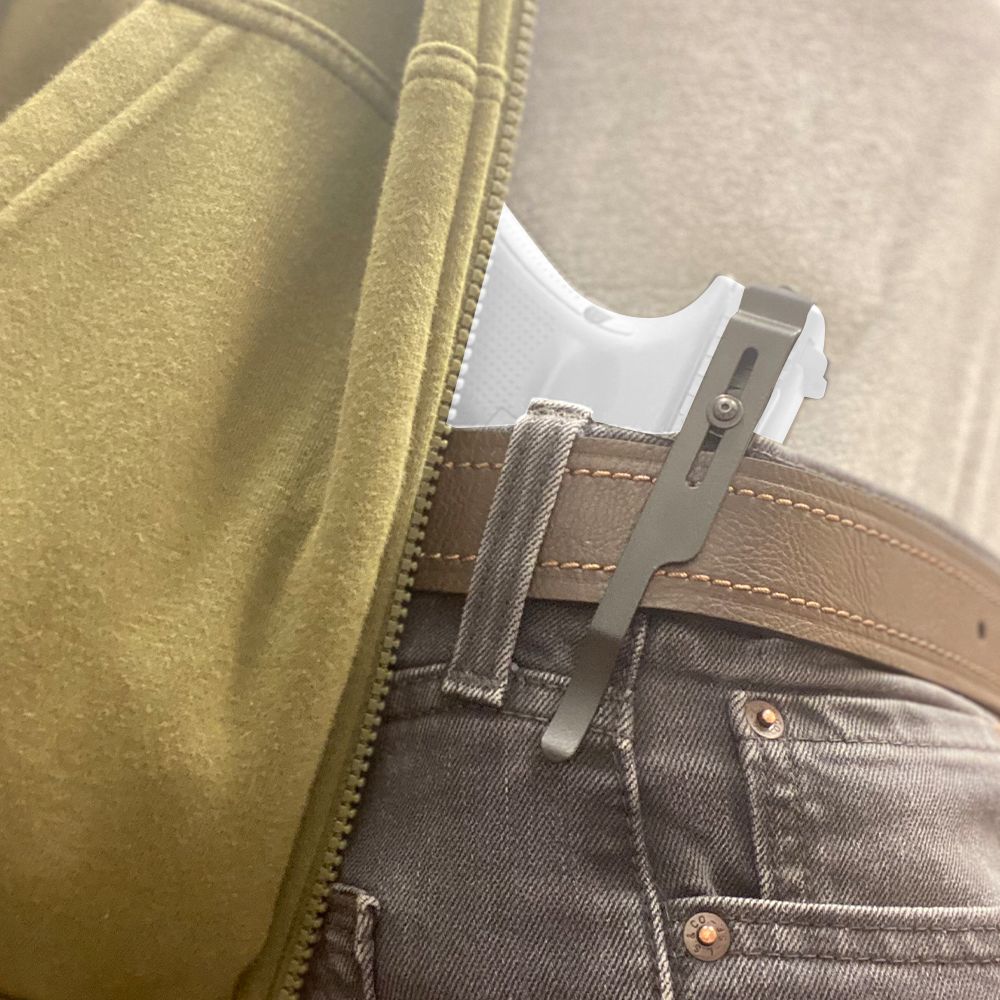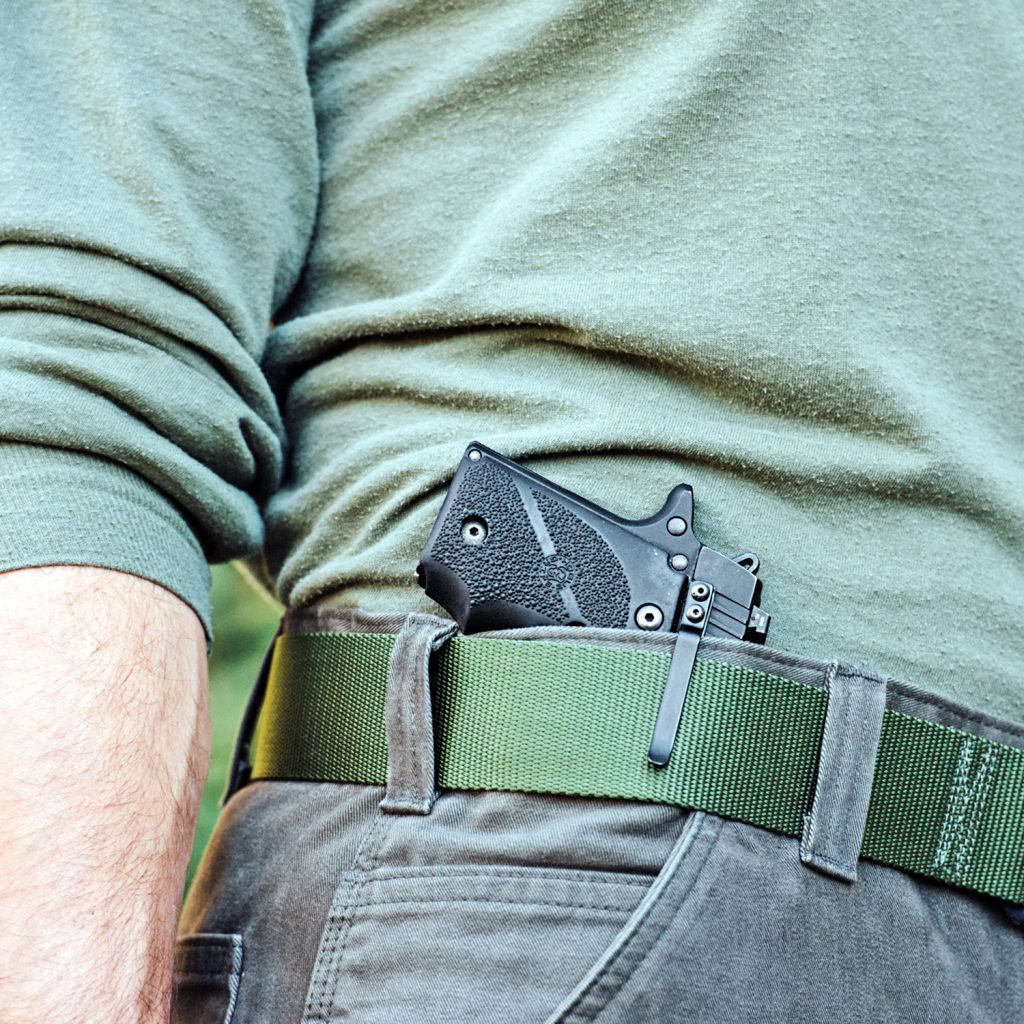Carrying concealed is about more than just strapping a gun to your belt and heading out the door.
It requires a combination of knowledge, skill, and practice to ensure both your safety and the safety of those around you.
Unfortunately, there are some common mistakes that even seasoned concealed carriers make, which can affect both their safety and the effectiveness of carrying.
In this article, we’ll explore the top 10 concealed carry mistakes and how to avoid them to ensure you’re carrying as safely and effectively as possible.
Choosing the Wrong Holster: Why Belt Clips Are a Better Alternative
Choosing the right carry method ensures both safety and comfort.
While traditional holsters are commonly used, they often present issues such as discomfort, bulkiness, and poor fit.
A poorly fitting holster can make drawing your firearm difficult, uncomfortable, and even dangerous in high-stress situations. Instead of wrestling with holsters that may not fit your specific gun perfectly, consider a high-quality alternative like the Clipdraw belt clip.
Our patented, universal gun clip fits all pistols, regardless of the make or manufacturer. The Clipdraw attaches directly to your firearm, giving you the option to adjust the depth of carry, whether you prefer deep concealment or maximum access. This slim and secure design provides superior comfort, avoiding the bulkiness and discomfort that often come with traditional holsters.
Cheap, low-quality holsters can do more harm than good. They may not retain your firearm securely, can hinder your draw, and often leave your gun more exposed to accidental discharge.
Clipdraw’s Belt Clip is an excellent alternative, offering a secure and discreet way to carry without the added bulk. Our clip requires just a small 3″ x 1/4″ mounting space and can be installed in minutes using patented 3M adhesive, with no drilling or tapping required. Plus, it’s proudly made in America and comes with a lifetime warranty and money-back guarantee.
If you’re tired of the discomfort and challenges of traditional holsters, consider the Clipdraw Belt Clip as the most discreet, effective, and secure way to carry your firearm
Not Practicing Drawing Your Firearm
You’ve got the holster, you’ve got the firearm, but can you draw it smoothly and quickly under pressure?
Many concealed carriers make the mistake of not practicing their draw, which can be critical in a self-defense situation. A quick and smooth draw could make all the difference in a high-pressure situation.
It’s important to practice drawing your firearm not just at home, but in various practice environments and while wearing different types of clothing. This will prepare you for real-world scenarios, so you won’t get caught off-guard.
Wearing Inappropriate Clothing While You’re Carrying
One of the biggest giveaways that someone is carrying a concealed pistol is its visibility due to wearing the wrong type of clothing.
Your clothing needs to conceal your firearm without printing or exposing it. Wearing clothing that’s too tight or not designed for carrying is a surefire way to draw attention – and not in a good way.
The key to dressing for concealed carry is striking a balance between comfort and concealment. Choose clothing that’s loose enough to hide your firearm but not so baggy that it becomes cumbersome.
Pay attention to the length of shirts and jackets, and always do a mirror check before leaving the house.
Ignoring Firearm Maintenance
Neglecting firearm maintenance is one of the most overlooked concealed carry mistakes.
Regular maintenance ensures your firearm is functioning properly and reliably. A dirty or malfunctioning firearm can jam at the worst possible time.
Even if you don’t fire your weapon often, regular cleaning is necessary to keep it in working order. Dust, sweat, and dirt can build up on your firearm, affecting its performance.
Remember, a well-maintained firearm is a reliable one.
Carrying with a Round in the Chamber
For many concealed carriers, especially those who are new to handling firearms, carrying a live round in the chamber can pose significant safety risks.
Accidental discharge is one of the most common concerns, and for good reason. A small mistake or lapse in concentration could lead to a serious incident.
Modern firearms are designed with multiple safety features, but no mechanical system is foolproof. Carrying without a round in the chamber provides an extra layer of safety, reducing the chances of an accidental discharge.
While this may require a split second to rack the slide in an emergency, it’s a worthwhile trade-off for those prioritizing safety, especially for newer carriers or those not in law enforcement.
For extra safety and to help prevent accidental discharge, we recommend adding a high-quality trigger guard to your list of concealed carry accessories.
Failing to Understand Local Concealed Carry Laws
Concealed carry laws vary from state to state, and even within different municipalities. Failing to know the laws where you live and travel can land you in legal trouble, even if your intentions are good.
Make it a habit to check local concealed carry laws whenever you’re traveling. Some places may have restrictions on where you can carry, what type of firearm you can carry, or even whether you need a permit.
Stay informed to stay safe – both legally and physically.
Showing the Outline of Your Firearm
“Printing” refers to when the outline of your firearm is visible through your clothing. This defeats the purpose of concealed carry and can make others uncomfortable or alert potential threats to the fact that you’re armed.
Avoid printing by choosing a holster designed for concealment and dressing appropriately. Wearing loose clothing and selecting a holster with a slim profile can help prevent printing. A ClipDraw belt clip can also help reduce bulk, making your firearm easier to conceal.
Not Paying Attention to Your Surroundings
Carrying a firearm comes with the responsibility of being extra aware of your surroundings.
Not paying attention to what’s going on around you is a common concealed carry mistake. Whether it’s identifying potential threats or understanding the environment, situational awareness is critical.
Avoid distractions, keep your head on a swivel, and always be aware of exits and potential cover. If you’re on your phone or daydreaming, you’re not prepared to react in a high-pressure situation.
Adjusting Your Firearm in Public
Fidgeting with your firearm in public can draw unwanted attention and make others suspicious. It also increases the risk of accidentally revealing your weapon.
If you need to adjust your firearm, do so in a private place like a restroom. Avoid touching or adjusting your holster in public unless absolutely necessary.
Relying on Your Firearm as Your Only Defense
A firearm is not a cure-all for self-defense.
One of the biggest concealed carry mistakes is relying solely on your gun to get out of dangerous situations. Learning de-escalation tactics and when to walk away from conflict is just as important.
In addition to your firearm, consider carrying non-lethal tools like pepper spray or a personal alarm. These can be effective for situations that don’t warrant deadly force.
Avoiding Mistakes Leads to Safer Concealed Carrying Practices
Concealed carry comes with great responsibility. By avoiding these common concealed carry mistakes, you can ensure that you’re prepared, safe, and effective in any situation. Whether it’s choosing the right holster, practicing your draw, or staying aware of your surroundings, every step you take matters. Remember, carrying a firearm isn’t just about protecting yourself – it’s about doing so responsibly.
Ready to take your concealed carry game to the next level?
Shop ClipDraw’s line of belt clips, trigger guards, and other accessories designed to help you avoid these common mistakes and carry with confidence!


